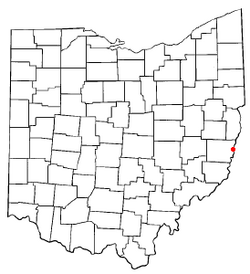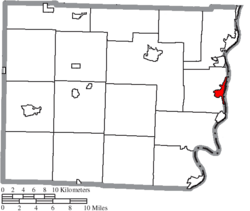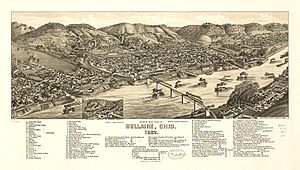Bellaire, Ohio facts for kids
Quick facts for kids
Bellaire, Ohio
|
|
|---|---|

Bellaire Bridge over the Ohio River
|
|

Location of Bellaire, Ohio
|
|

Location of Bellaire in Belmont County
|
|
| Country | United States |
| State | Ohio |
| County | Belmont |
| Township | Pultney |
| Area | |
| • Total | 1.68 sq mi (4.35 km2) |
| • Land | 1.65 sq mi (4.28 km2) |
| • Water | 0.03 sq mi (0.07 km2) |
| Elevation | 709 ft (216 m) |
| Population
(2020)
|
|
| • Total | 3,870 |
| • Estimate
(2023)
|
3,763 |
| • Density | 2,341.20/sq mi (904.14/km2) |
| Time zone | UTC-5 (Eastern (EST)) |
| • Summer (DST) | UTC-4 (EDT) |
| ZIP code |
43906
|
| Area code(s) | 740 |
| FIPS code | 39-05074 |
| GNIS feature ID | 2398073 |
Bellaire is a small village in Belmont County, Ohio, United States. It is located right along the Ohio River. In 2020, about 3,870 people lived there. Bellaire is part of the larger Wheeling metropolitan area.
You might have even seen Bellaire in movies! The old Bellaire Bridge was shown in the 1991 movie The Silence of the Lambs. Also, the curved railroad bridge, called the B & O Railroad Viaduct, was featured in the 2010 film Unstoppable. This bridge is a special historic building.
Contents
A Look Back in Time
Long ago, before European settlers arrived, Native American groups called Mound builders lived along the Ohio River. They built amazing earthworks. Later, tribes like the Mingo, Shawnee, and Delaware lived in this area.
The first Europeans to visit the Ohio River Valley were French explorers and priests in the 1700s. They were amazed by the beautiful, hilly shores and the many fish and animals. Even young George Washington explored these lands before the American Revolutionary War.
How Bellaire Began
The land where Bellaire now stands changed hands many times. In 1834, John Rodefer and Jacob Davis bought a large part of the land. They planned out building lots for a new village. They named it "Bell Air" after Jacob Davis's old home in Maryland. Soon, more settlers came, and the town started to grow.
A fun local story is about Jacob Heatherington, who built a house known as "The House That Jack Built." This refers to his mule, Jack, who helped carry all the building supplies. When the house was finished, Jacob even led Jack through every room to show him what they had built!
The Railroad Arrives
A big change for Bellaire happened in 1853 when the Central Ohio Railway was built. This railway later became part of the Baltimore and Ohio (B&O) Railroad. The B&O built a large stone bridge, called the Stone Viaduct Bridge, which opened in 1871. This bridge connected Bellaire to Wheeling, West Virginia. The railroad was very important because it helped connect cities on the East Coast, like Baltimore, with markets in the west. The railroad company later officially renamed the town to Bellaire.
Bellaire During the Civil War
Bellaire was important during the Civil War. It was located on the border between Ohio, which supported the Union, and Virginia, which had left the Union. Because of its location and the railroads, Camp Jefferson was set up in Bellaire. This was a military training camp for Union soldiers. Many soldiers left from Bellaire using the Baltimore and Ohio Railroad to travel south.
The "Glass City" Era

From about 1870 to 1885, Bellaire was known as the "Glass City." This was because many glass factories opened here. Bellaire had everything needed for glassmaking:
- Great Transportation: The Ohio River, the National Road, and railroads made it easy to move materials and finished products.
- Local Energy: There was plenty of coal nearby in Belmont County to fuel the factories.
- Skilled Workers: People who knew how to make glass had been working across the river in Wheeling since the 1820s.
Many glass companies operated in Bellaire, including Belmont Glass Works and Bellaire Window Glass Company. However, in the late 1880s, natural gas was discovered in the Findlay, Ohio area. This new, cheaper energy source caused many glassmakers to move west. The area around Toledo and Fostoria became the new center for Ohio's glass industry.
During a coal miners' strike in 1894, there was a clash between striking workers and troops just west of Bellaire.
Imperial Glass Museum
One of the most famous glass companies in Bellaire was the Imperial Glass Company. It was started in 1901 by Edward Muhleman and began making glass in 1904. Imperial Glass was known for making beautiful and affordable pressed-glass tableware. They also made blown glass and special art glass. Their "Candlewick" pattern was very popular.
Imperial Glass was one of the largest handmade glass manufacturers in the United States during the 20th century. Sadly, the company closed in 1984, and its building was taken down in 1995. Today, their glassware is still highly valued by collectors.
The Imperial Glass Museum in Bellaire celebrates the history of Imperial Glassware and other glass from the Ohio Valley. It also honors the people who worked at the Imperial factory. The National Imperial Glass (NIG) Collectors Society helps keep the story of Imperial Glass alive through the museum.
What's Bellaire Like Today?
Bellaire is a small village with a total area of about 1.68 square miles (4.35 square kilometers). Most of this area is land, with a small part being water.
Population Changes
| Historical population | |||
|---|---|---|---|
| Census | Pop. | %± | |
| 1860 | 1,466 | — | |
| 1870 | 4,033 | 175.1% | |
| 1880 | 8,025 | 99.0% | |
| 1890 | 9,934 | 23.8% | |
| 1900 | 9,912 | −0.2% | |
| 1910 | 12,946 | 30.6% | |
| 1920 | 15,061 | 16.3% | |
| 1930 | 13,327 | −11.5% | |
| 1940 | 13,799 | 3.5% | |
| 1950 | 12,573 | −8.9% | |
| 1960 | 11,502 | −8.5% | |
| 1970 | 9,655 | −16.1% | |
| 1980 | 8,231 | −14.7% | |
| 1990 | 6,028 | −26.8% | |
| 2000 | 4,892 | −18.8% | |
| 2010 | 4,278 | −12.6% | |
| 2020 | 3,870 | −9.5% | |
| 2023 (est.) | 3,763 | −12.0% | |
| U.S. Decennial Census | |||
According to the 2010 census, there were 4,278 people living in Bellaire. The population density was about 2,593 people per square mile. Most residents were White (91.9%), with African Americans making up 5.5% of the population.
The average age in Bellaire in 2010 was 38.9 years old. About 23.4% of the residents were under 18, and 15.9% were 65 or older.
Education in Bellaire
Bellaire has several schools for students. These include Bellaire High School, St. John Central Grade School, and St. John Central High School. The Bellaire Public Library is located in the Mellott Memorial Building.
Famous People from Bellaire
Many notable people have come from Bellaire, especially in sports!
- Mike Basrak – A professional football center.
- John Buddenberg – Football player drafted by the Cleveland Browns.
- Mac Cara – A professional football end.
- Lester Carney – Won a silver medal in the 200m race at the 1960 Summer Olympics.
- Henry Crimmel – A Civil War veteran and co-founder of Novelty Glass Company.
- Nate Davis – A professional football quarterback.
- Jose Davis – Professional football player in the CFL and AFL.
- Andy Dorris – A professional football defensive lineman.
- Todd Fitch – A college football coach.
- Joey Galloway – A professional football wide receiver and ESPN analyst.
- Bill George – A pitcher in Major League Baseball.
- Tod Goodwin – A professional football player for the New York Giants.
- Carl C. Johnson – A retired U.S. Army officer and Tuskegee Airmen cadet pilot.
- George "Chappie" Johnson Jr. – A baseball catcher and manager in the Negro leagues.
- Jim Keane – A professional football player for the Chicago Bears.
- Brickyard Kennedy – A professional Major League Baseball pitcher who played in the first World Series.
- Ron Lee – A professional football player for the Baltimore Colts.
- Ted Levine – An actor.
- John McVay – A head coach for the NFL's New York Giants and general manager for the San Francisco 49ers.
- Lance Mehl – A professional football linebacker for the New York Jets.
- Bob Ney – A former U.S. House Representative.
- John Niemiec – A Notre Dame football star.
- Stan Olejniczak – A professional football player for the Pittsburgh Pirates.
- Bull Polisky – A professional football player for the Chicago Bears.
- Nick Skorich – A former NFL player and head coach for the Cleveland Browns and Philadelphia Eagles.
- Ben Taylor – A professional football linebacker.
- Chalmers Tschappat – An early NFL player.
- Francis Wallace – An author, Hollywood screenwriter, and sportswriter.
- Sol White – A baseball infielder, manager, and sportswriter, now in the National Baseball Hall of Fame.
Images for kids
-
Flooding of the Ohio River in 1937
See also
 In Spanish: Bellaire (Ohio) para niños
In Spanish: Bellaire (Ohio) para niños






